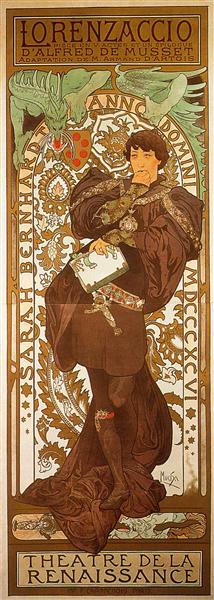Description
Alfons Much "Lorenzaccio", presented in 1896, is a notable manifestation of the author's style, firmly anchored in the Art Nouveau, a movement characterized by its attention to ornate detail and a deep connection with nature. Much, central figure of the movement, is known for its ability to merge the ornamental with the narrative, and "Lorenzaccio" is no exception.
In this painting, much explores the issue of the duality of the human being, particularly through the figure of Lorenzo de Médici, who is portrayed introspectively. The composition focuses on the figure of Lorenzo, which occupies the space in a dominant but at the same time vulnerable way, a reflection of the internal conflict and the complexities of its character. His posture is loaded with a palpable tension, with a look that suggests both determination and melancholy. The choice of a dark and gloomy background highlights its central figure, contributing to the dramatic atmosphere of the work.
The use of color by much is very significant in "Lorenzaccio". The dark palette, predominated by brown and gray tones, contrasts with the vibrant accents of blue and gold, which provide both depth and wealth. This contrast not only emphasizes the figure of the character, but also suggests the emotional tumult it faces. This approach to the emotional atmosphere of colors is a distinctive feature of much painting, who not only seeks to represent reality, but also evoke an emotional response in the viewer.
As for the compositional elements, Lorenzo's disposition in space resembles classical compositions, where the visual balance is manifested through lines that lead the viewer's gaze towards his figure. The fluidity of the lines and decorative details surrounding the image, although minimal, are iconographic of the Art Nouveau style, which idolized the ornamental and aesthetic beauty in everyday life.
An aspect that is often overlooked in the works of Much is its ability to tell stories through iconography. In "Lorenzaccio", the subtle elements, such as the decoration of the background or the shadows that surround the character, can be interpreted as allusions to the complex plot of the theatrical work that inspired the painting. Much is immersed in the character's narrative, capturing not only his physical appearance but also the essence of his moral and ethical dilemmas.
Entering the context of the work, it is important to note that "Lorenzaccio" was created in a time where art was in a constant search to redefine its role in society. The transition of the styles of realism towards symbolism and modernism left a mark on artists like much, who dared to explore issues that resonated with the public of their time, connecting artistic representations with the social problems of modernity.
In summary, "Lorenzaccio" by Alfons Much is a work that amalgamates the refined technique of its author with a narrative depth that invites reflection. Through its use of color, the careful composition and emotional representation of its protagonist, a lot of masterful balance between beauty and meaning, solidifying its legacy in the history of art. This work is not only a testimony of its artistic ability, but also a window to the complexity of the human condition, a timeless theme that continues to resonate with the contemporary spectator.
KUADROS ©, a famous paint on your wall.
Hand-made oil painting reproductions, with the quality of professional artists and the distinctive seal of KUADROS ©.
Art reproduction service with satisfaction guarantee. If you are not completely satisfied with the replica of your painting, we refund your money 100%.

